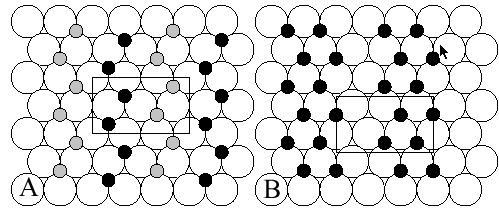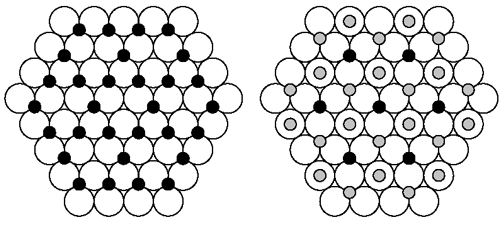CVD Alumina

CVD of alpha alumina
Multilayers of TiC/alpha-Al2O3 consisting of three alumina layers separated by thin (∼10 nm) oxidized TiC layers have been deposited onto c-, a- and r-surfaces of single crystals of alpha-Al2O3 by chemical vapour deposition (CVD). It was shown that the TiC layers can be affected differently when oxidized. This is important since the TiC surface affects the subsequent deposition of Al2O3. However, alpha-Al2O3 formed in all cases, even when the TiC layer was oxidized to a TiCO phase with a monoclinic structure.

HREM and FFT images of CVD alpha alumina deposited on oxidized TiC.

During a short oxidation step the originally deposited fcc TiC layer can incorporate oxygen and form an fcc TiCO phase (on the c- and a-surfaces), or monoclinic TiCO (on the r-surface), see Figure below.

Thus, the TiCO unit cell has (340)m in the coating direction, which corresponds to (100)c. The originally deposited TiC layer had a cubic structure. After the oxidation stage the cubic TiC incorporated oxygen and trans- formed to a monoclinic structure. It is well known that TiC has an fcc structure (Pierson, 1996), while TiO has a monoclinic structure (Watanabe et al., 1967). It is likely that the structure of the TiCO formed during oxidation is strongly dependent on its C/O ratio. A high C/O ratio increases the probability for formation of a TiC-like structure (fcc), while a low C/O ratio probably favours formation of a TiO-like structure (monoclinic).
An extended oxidation step may lead to formation of different titanium oxides (e.g. TiO, TiO2, Ti2O3, Ti3O5). Excessive oxidation of the TiC layer prior to or during initial alumina layer deposition may result in considerable expansion of the TiC layer. Therefore, it is probably important to have low oxidizing conditions for the TiC layer during the oxidation step and the initial alumina layer deposition. In general, the TiC oxidation step is a sensitive and important part of the CVD process of these types of multilayer coatings.
Alumina crystal structures
Alumina crystallises in a number of different modifications. The three most important for deposition by CVD and PVD are alpha (stable), kappa (metastable) and gamma (metastable). We have worked a lot with crystal structure determinations for kappa as well as the phese transformation kappa - alpha at elevated temperature. Also the deposition of gamma has been treated.
Kappa alumina
Kappa alumina has an orthorhombic crystal structure (Pna21) with close-packed planes of oxygen in an ABAC stacking sequence along the c-axis.1/4 of the Al ions occupy tetrahedral interstitial positions and 3/4 occupy octahedral positions. The tetrahedrally coordinated Al ions form zig zag lines along [100] in the structure as can be seen in the figure below (left). There are also vacancy lines in the structure along [100] as can be seen in the figure below (right).

Schematic drawing of the first two layers in the kappa alumina structure. Octahedral Al ions are black, tetrahedral are grey.
Gamma alumina
Gamma alumina is cubic with space group Fd-3m and is based on an fcc . . .ABCABC. . . stacking of oxygen. The structure is often described as a defect cubic spinel structure with vacancies on part of the cation positions. Each unit cell contains 32 oxygen and 64/3 aluminium ions to fulfill stoichiometry . The aluminium ions occupy both octahedral and tetrahedral positions, but the relative partial occupancy in each position is still a matter of dispute.

Schematic drawing of the first two layers in the gamma alumina structure.
Alpha alumina
Alpha alumina is the only stable alumina phase at all temperatures. It has a trigonal structure (R-3c) and is usually described as ABAB stacking of oxygen planes along the c-direction with Al ions in 2/3 of the octahedral interstitial positions.

Schematic drawing of the first layer in the alpha alumina structure.
